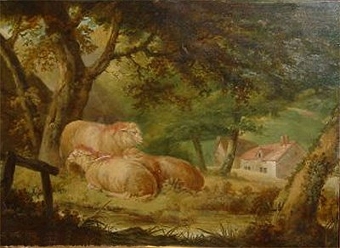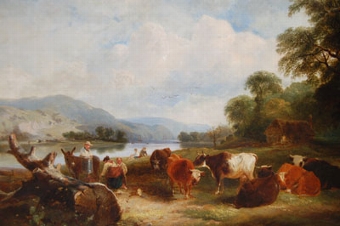Gloucester Docks was painted in the last year of his life and was likely left unfinnsied but completed by his son.
Grimshaw was born 6 September 1836 in Leeds. In 1856 he married his cousin Frances Hubbard (1835-1917). In 1861, at the age of 24, to the dismay of his parents, he departed from his first job as a clerk for the Great Northern Railway to pursue a career in art. He began exhibiting in 1862, under the patronage of the Leeds Philosophical and Literary Society, with paintings mainly of birds, fruit, and blossoms.He became particularly successful in the 1870s and was able to afford to rent a second home in Scarborough, which also became a favourite subject.
Grimshaw''s primary influence was the Pre-Raphaelites. True to the Pre-Raphaelite style, he put forth landscapes of accurate color and lighting, and vivid detail. He often painted landscapes that typified seasons or a type of weather; city and suburban street scenes and moonlit views of the docks in London, Leeds, Liverpool, and Glasgow also figured largely in his art. By applying his skill in lighting effects, and unusually careful attention to detail, he was often capable of intricately describing a scene, while strongly conveying its mood. His "paintings of dampened gas-lit streets and misty waterfronts conveyed an eerie warmth as well as alienation in the urban scene."
Dulce Domum (1855), on whose reverse Grimshaw wrote, "mostly painted under great difficulties," captures the music portrayed in the piano player, entices the eye to meander through the richly decorated room, and to consider the still and silent young lady who is meanwhile listening. Grimshaw painted more interior scenes, especially in the 1870s, when he worked until the influence of James
On Hampstead Hill is considered one of Grimshaw''s finest, exemplifying his skill with a variety of light sources, in capturing the mood of the passing of twilight into the onset of night. In his later career this use of twilight, and urban scenes under yellow light were highly popular, especially with his middle-class patrons.His later work included imagined scenes from the Greek and Roman empires, and he also painted literary subjects from Longfellow and Tennyson ? pictures including Elaine and The Lady of Shalott. (Grimshaw named all of his children after characters in Tennyson''s poems.)
In the 1880s, Grimshaw maintained a London studio in Chelsea, not far from the comparable facility of James Abbott McNeill Whistler. After visiting Grimshaw, Whistler remarked that "I considered myself the inventor of Nocturnes until I saw Grimmy''s moonlit pictures."Unlike Whistler''s Impressionistic night scenes, however, Grimshaw worked in a realistic vein: "sharply focused, almost photgraphic," his pictures innovated in applying the tradition of rural moonlight images to the Victorian city, recording "the rain and mist, the puddles and smoky fog of late Victorian industrial England with great poetry."
Some artists of Grimshaw''s period, both famous and obscure, generated rich documentary records; Vincent Van Gogh and James Smetham are good examples. Others, like Edward Pritchett, left nothing. Grimshaw left behind him no letters, journals, or papers; scholars and critics have little material on which to base their understanding of his life and career.
Grimshaw died 13 October 1893, and is buried in Woodhouse cemetery, Leeds. His reputation rested, and his legacy is probably based on, his townscapes. The second half of the twentieth century saw a major revival of interest in Grimshaw''s work, with several important exhibits of his canon.
The Main Basin at Gloucester was constructed as the terminus of the ship canal with an entrance from the Severn estuary at Sharpness. As the work was nearing completion, there was concern that the basin would not be large enough for the trade expected, and so an additional Barge Arm was constructed to ensure that the Main Basin could be kept free for sea-going ships. In addition, the Canal Company built a warehouse at the north end of the basin. The canal was formally opened on the 26 April 1827, and a huge crowd gathered to watch the first two vessels enter the basin amid the firing of guns and the ringing of church bells.Once the canal was fully operational, local merchants were soon taking advantage of the new facilities. Importing through Gloucester cut out the former need for transshipment at Bristol, where there were high port charges. Cargoes could be transferred direct to narrow canal boats which could carry the goods up the river and through the inland canals to supply the growing industrial towns of the Midlands. The geographical position of Gloucester so far inland was a tremendous advantage, and traffic was soon exceeding all expectations. As well as the trows and barges employed in the existing river and coastal trade, there were increasing numbers of two-masted brigs and schooners and some three-masted barques. Early imports included corn from Ireland and the Continent, timber from the Baltic and North America, and wines and spirits from Portugal and France. The main export was salt which was brought down the river from Worcestershire.
To cope with all this activity, warehouses were built around the Main Basin, an earlier dry dock was enlarged, and an engine house was built to augment the canal''s water supply by pumping from the River Severn. To extend the quay space, Bakers Quay was constructed along the canal, and this was mainly laid out for timber yards. Large storage yards were necessary as the timber loading ports were iced-up during the winter and most of the imports arrived during the summer and autumn. Several of the yards were surrounded by high fences and were locked up under customs supervision so that foreign timber could be stored there without paying import duty. Some of the ships bringing timber from North America were locally owned, and they often carried emigrants on the outward journey.
During the 1840s, it was realised that further developments would be necessary. At busy times, the basin became so crowded that vessels had to wait their turn for a berth. Also, there was a national movement towards reduced import duties, and particularly following the repeal of the Corn Laws in 1846, the Canal Company recognised they should prepare for a major increase in foreign imports. They therefore arranged for the Victoria Dock to be constructed to the east of the Main Basin with a narrow cut linking the two, and the new dock was opened in 1849. At the same time, further corn warehouses were built and new timber yards were established.Also during the 1840s, there were various moves to bring railway connections into the docks. First the Midland Railway constructed a standard gauge line from their station to the south end of Bakers Quay with a branch serving the east side of the main docks area, and later the Great Western Railway operated a broad gauge branch from the South Wales line to serve a new quay on the west side of the canal. These lines were increasingly used to distribute imports to the Midlands in competition with the river and canal route.
With the benefit of the improved facilities, foreign imports increased dramatically during the 1850s and 60s. Corn came from northern Europe and the Black Sea ports situated around the mouth of the Danube, further warehouses were constructed and three flour mills were established. Timber came from the Baltic, North America and the arctic coast of Russia, and new timber yards and saw mills were established beside the canal south of Gloucester. Other imports included wines and spirits, oranges and lemons, and bones and guano for fertiliser. Unfortunately, salt was still the only regular export, and most vessels chose to go elsewhere to find a return cargo.During the 1860s, difficulties were reported because the general increase in the size of merchant ships meant that some were too big to come up the canal fully laden. The Canal Company therefore built a new entrance and dock at Sharpness that would take the largest ships of the day. The new dock opened in 1874, and this allowed the growth in imports to continue. The smaller boats came up the canal as before, whilst cargoes from the larger vessels were transhipped at Sharpness and brought up the canal in barges and lighters.
By the early years of the twentieth century, the docks were being used by steamers as well as by sailing vessels, and there were regular services to continental ports. However, the continuing increase in the size of merchant ships, particularly steamers, meant that a growing proportion of the goods coming to Gloucester arrived in barges and lighters from Sharpness or other Bristol Channel ports. Much of the corn was sent straight on to the Midlands, and this led to a decline in the use of the warehouses at Gloucester. During the 1920s, new traffic was generated by the demand for petroleum products for the growing number of road vehicles with internal combustion engines. This became very important in the years following, and a fleet of tanker barges was used to bring the petroleum from Avonmouth. Some of the barges continued up the river to depots at Worcester and Stourport.
The old Canal Company was nationalised in 1947, and the new management set about encouraging more sea-going ships to come up to Gloucester. The docks also remained busy with barge traffic well into the 1960s. The petroleum traffic then declined rapidly following the construction of underground pipelines and the establishment of a depot at Quedgeley, and the other barge traffic came to an end in the face of competition from road transport. By 1980, virtually the only remaining commercial vessels were the coasters coming to the quays south of Llanthony Bridge. As the commercial traffic died away, it was partly replaced by an increase in pleasure craft, and the docks became a popular place for moorings. The survival of the old warehouses made the Main Basin an ideal location for filming historical drama, and many scenes for the popular television series The Onedin Line were filmed in front of Biddle Warehouse. In recent years, new uses have been found for the warehouses, and the docks are developing as a popular leisure and residential area.
Antiques.co.uk Ref: MRWPMXV9
- Materials:
- Oil on Canvas
- Width (cm):
- 45.72 x 30.48 cm 18.00 x 12.00 ins












